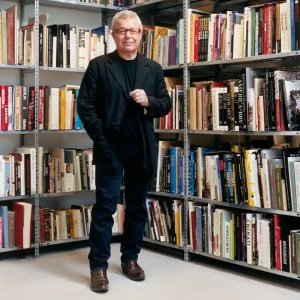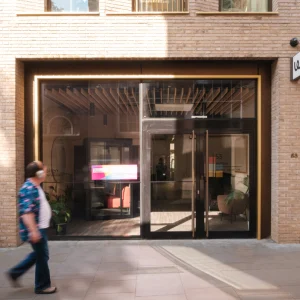
In the late Seventies, the now late Ian MacDonald, the era’s best homegrown rock music writer, conducted one of the longest interviews that the then hipper-than-thou New Musical Express had ever published. In the two-part, 20,000 worder, MacDonald described his subject, the ex-Roxy Music non-musician Brian Eno, as ‘one of the great talkers of his generation’.
Yet the piece was also an early example of how Eno was equally adept at exciting pale, young, music obsessives into writing at length on the exotic electronics buff and his many and varied theories and concepts, so different to much of the music world.
While Eno moved on to become a celebrated studio producer — and career redefiner — of the likes of David Bowie, Talking Heads, U2 and James, the words and articles continued to stack up. Over the decades cultural writer types,
beguiled by the hyper-articulate and intellectually adroit Eno, helped make him one of the most written-about figures working across the blurred boundaries of popular and one-time avant-garde music, art, technology and evolutionary thinking. A veritable bookshelf of books has followed, adding to the many interviews, TV documentaries and other media paraphernalia accredited to the idiosyncratic rock something’s name.
These books, including a few by Eno himself, have primarily focused on his music, even if the attraction to many Eno-watchers has been the originality of his disciplinaryupending, charmingly presented, one-man-aesthetics-and-ideas professorial showcase. This seemed to unfold in the real time of interview situations, and was generally alluring in a way that more orthodox radical tendencies of the times — say Eighties postmodernism — wasn’t.
Up until late last year, however, there hadn’t been any book on a strand of Eno’s work that has received less attention than the headliner music studio producer to the stars: his ongoing work with visual art practice, specifically the ambient video art work. From 1979, when he moved to New York, this quiet strand has continued, transferring on to new media-based technology, and specifically generative or algorithmic software, resulting in recent works such as 77 Million Paintings.
This omission of publicity has now been filled with Christopher Scoates’ warmly appreciative Visual Music. This tells the long story of Eno’s art, and more specifically the ‘visual ambient’ journey, from early student days at Ipswich and Winchester art schools, through music notoriety and after, to presentday activities, such as his presence among The Long Now luminaries, and forays into the country’s wider political cultural life, turning up on Radio 4’s Any Questions, and being the 60-plus adviser to Nick Clegg on youth culture.
All this acceptance suggests that the art battles, which so animated the young Eno have long been won, and the arguments — today very much part of the mainstream — are clearly present within Visual Music’s narrative. When in the first of a four-part essay, The Aesthetics of Time, Scoates outlines Eno’s well-known dislike for the pillars of traditional, old-school classical and heroic art aesthetics, you are immediately returned to the rationales of the art experiments diligently documented in the book’s opening sections, even if they don’t go anywhere near possible psychological sources of Eno’s passionate (angry?) aesthetics arguments.
This is interesting as historical documentation, highlighting how time-consuming and exacting Eno was in his early work. But it is when the documentation of the videos (begun when Eno happened to turn a TV screen on its side in his New York flat, and saw the world differently, marking the emergence of ambient video and the move from analogue to ambient music) that the story takes on more than academic interest.
The various phases of Eno’s moving image work, intensely slow ‘and ignorable as they are interesting’ are extensively detailed, including drawings, plans, and stills from luminous videos, including Memories of Medieval Manhattan, Quiet Club and The Future will be like Perfume.
As for words, there are six essays, an Eno lecture, and an end-piece interview with the non-musician. Editor Scoates contributes his four-part The Aesthetics of Time essay, locating the ancestry of Visual Music, along with an intriguing meditation by Brian Dillon on Eno as a landscape artist, paired with WG Sebald’s Suffolk wanderings, and a younger generation, new-media curator, Steve Dietz, who is invited to link Eno’s generative and other algorithmic experiments to newmedia land — which, for those to whom words are significant may find noticeably shallow and grating after Dillon’s careful eloquence.
At times the accessible, contextualising essays can seem a tad overdone. Plainly hagiographic, and void of real critical bite despite Eno’s anti-heroic endeavours, Visual Music can look like yet another celebratory, almost ‘great man’, art book. The narrative moves in terms of chronology from simple student experiments at the beginning of the book, through Eno’s very funny lecture contribution, Perfume, Defence, and David Bowie’s Wedding, to the picture section: 77 Million Paintings beamed on to the Sydney Opera House, a kind of climatic finale to the story so far.
Eno at the Sydney Opera House is illustration enough of the paradoxes of success. As, of course, is this book.





